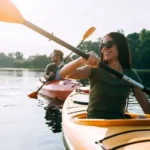For those looking to get out on the water and explore nature, camping with a canoe can be one of the most memorable experiences. But how to pack a canoe for camping? Whether you’re an experienced camper or just starting, it pays to pack a canoe for your next outdoor adventure properly.
How To Pack A Canoe For Camping | Pro Guide
Organization is Key
Before loading anything into your canoe, it’s important to plan how you want everything organized. This way, you can ensure that all your items fit safely and securely in the boat while leaving room for paddlers.
Make sure that heavier items are placed closer to the ship’s center; this helps keep your canoe balanced while in the water. Also, invest in waterproof containers and bags; these will help keep your gear dry if you happen to capsize or get stuck in inclement weather.
Pack Smart
You don’t need to bring along every item you own when packing for a canoe trip; instead, focus on bringing essential items such as food, water, clothing and shelter. Investing in lightweight equipment such as sleeping bags and tents will also help reduce excess weight.
Additionally, many campers like to bring fishing poles or other recreational items, but ensure they are securely tied down before heading out onto the water!
Use Straps & Tie-Downs
Once all your gear is loaded into your canoe, it’s important to use straps and tie-downs to ensure everything stays secure during transit.
Many canoes come with pre-installed straps and tie-downs; however, if you have no straps installed, consider buying some from an outdoor goods store before embarking on your trip. The last thing you want is for all your gear to fly overboard!
Also Read: Will A Skin On Frame Canoe Hold Much Camping Gear?
What Are The 3 Golden Rules Of Canoeing?

Canoeing can be an incredibly enjoyable and rewarding experience, but it’s important to understand the basic safety rules before setting out on any canoe trip. Here are three golden rules of canoeing that should always be remembered:
1. Wear a Personal Floatation Device (PFD). Wearing a PFD is essential when you’re in or near the water. It can protect you from hypothermia if you end up in cold water, help you float better, and even keep your head above water if necessary. Wear one whenever and however applicable – even if it doesn’t feel necessary, it might save your life someday!
2. Check the weather before heading out on your voyage. Weather conditions should always be considered before any outdoor activity – especially travelling over sometimes-treacherous waters! Pay close attention to potentially hazardous conditions like thunderstorms or high winds, as these can quickly turn a peaceful journey into an extremely dangerous situation in no time.
3. Learn proper paddle techniques and obey navigation laws for different waterways. Before taking off down any body of water, make sure that you understand how to safely navigate its currents and eddies; what kinds of laws apply; what type of wildlife may inhabit those waters; any restrictions that may apply, such as no motorized vessels; areas where boats have right-of-way over each other; etcetera – so that everything goes smoothly while out on the lake or river!
Also Read: Must Have Canoe Camping Gear?
How Do You Balance A Canoe?
Balancing a canoe is something that takes experience to perfect. Rolling over the sides and swimming when you are just starting is easy. For the untrained, the most difficult part of canoeing is learning to shift your centre of gravity to remain stable in choppy or windy waters – essentially, balancing yourself correctly.
Much of it comes down to practice: get out on the water as often as possible and pay special attention to where your body weight is relative to the middle of the canoe.
You can lean slightly towards whichever side you need more stability on, but remember not to put too much pressure on one side, or you will risk tipping out.
Even experienced canoeists need repeated drills and exercises to stay sharp with their balance whenever they take a paddle out. So if you’re still mastering how to stay afloat, don’t worry – consistent practice and attention should soon have you feeling like a pro!
Also Read: How To Lash Down Camping Gear In A Canoe?
Bottom Line:
How to pack a Canoe for camping? Packing a canoe for camping doesn’t have to be complicated—all it takes is planning and smart packing decisions! Start by making sure that all your heavier items are placed towards the center of the boat, and invest in waterproof containers and bags so that nothing gets wet if you end up capsizing or getting stuck in inclement weather.
Finally, ensure everything is secured with straps or tie-downs before departing on your journey! With these tips in mind, nothing stops you from having an amazing camping experience with a well-packed canoe!



